Kilopower space reactor
An interesting NASA / DOE project eluded me in preparation for previous reviews of space reactors [ 1 , 2 , 3 ]. This is the easiest and simplest version of a nuclear reactor, designed to replace the plutonium RTGs in both long-range space missions and the power supply of small astronaut bases, in any case, according to the creators.
The project is interesting because many conventions in appearance have been rejected here that prevail in different paper reactors, and the low level of complexity allows us to make the design as simple as that of RTGs, which in fact can lead this project to success. The simple design and the correct ideology make it possible to go through the development stages at a very high speed, which is not typical of decades of space nuclear reactor projects.
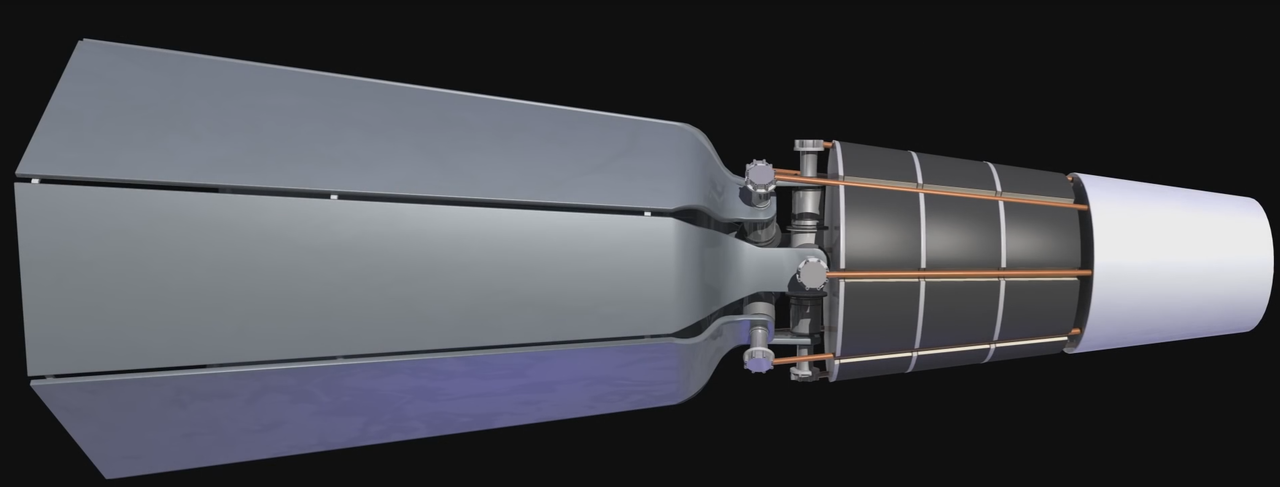
The conceptual image of Kilopower, from left to right, is radiators / refrigerators, 2 assemblies of Stirling generators, radiation protection and heat pipes, a reflector of a beryllium oxide reactor (a reactor inside it).
Kilopower power should be from 1 to 10 kW of electric (and 4 times higher - thermal, which gives a efficiency of 25%), and be configured for a specific mission. What is interesting, as I understand it, only the heat-electric part will change from power, and the nuclear part, in fact, will remain approximately the same for all options. The reactor, which is being worked out in the American laboratory of LANL, is a cylinder made of 7% molybdenum alloy and highly enriched uranium 235, which (HEU) is for some reason afraid of space reactor developers, although no terrorists or dictators behind Jupiter’s orbit have yet been found. The cylinder diameter is ~ 11 cm, length 25 cm, weight ~ 35 kg, inside there is a channel 3.7 cm in diameter, where the only boron carbide rod is located.

Molybdenum in the alloy with uranium is needed here to impart mechanical strength and stability of uranium to phase transitions during heating, and reactivity is regulated by boron carbide neutron absorber from boron carbide - in the inserted state the reactor is subcritical even when released into water, in the seized (once and for all) - goes to the criticism and gaining thermal power. Power is governed by the geometry of the reactor and the reflector, which is chosen so that when heated to 1200 K, the thermal expansion of the uranium alloy of the reactor reduces Keff (the neutron ratio in the next generation) strictly to 1, and then it will warm up for more than 10 years with the ongoing chain reaction.
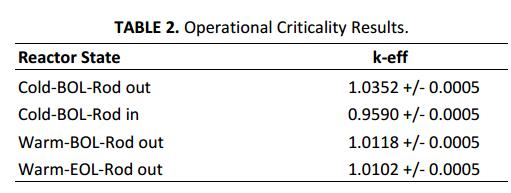
Plate with calculated Keff reactor: 1) a cold reactor with a withdrawn rod, 2) a cold reactor with a rod inserted, 3) a heated reactor with a withdrawn rod at the start of operation 4) a heated reactor with a withdrawn rod after 10 years of burnout.
The reactor is surrounded by a neutron reflector (to reduce the critical mass) of beryllium oxide, into which heat pipes are inserted - and this is absolutely the whole construction of the reactor itself. Between the block of energy converters and the active zone there is a segment (shadow, protecting only in one direction) radiation protection from layers of lithium hydride and tungsten.
The most amazing thing in my opinion is the absence of a shell in the uranium core - it is not needed in space, on earth this reactor never starts up. It remains only to envy the unbeaten thinking and the lack of atomic surveys in the orbit of Neptune.
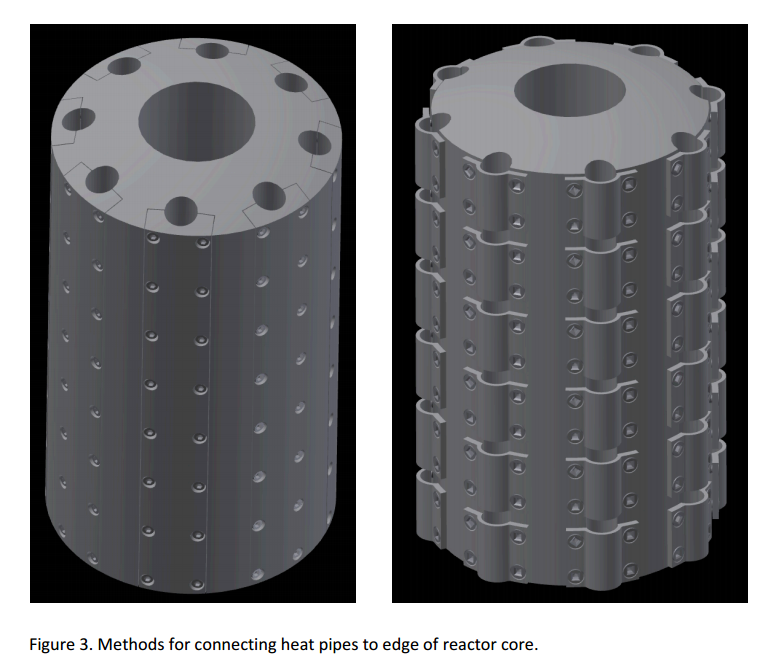
The reactor core and two options for fixing heat pipes on it. By the way, fixing heat pipes to uranium is one of the unexpectedly difficult problems in this development, mainly because the remaining elements of the reactor are simple or have been worked out.
Heat removed from the core and the reflector by heat pipes is supplied to the hot ends of the Stirling generators (in different studies of the reactor their number and power are different, but probably about 4-16 pieces), and their cold ends are connected to radiator coolers. Here, too, there is a robust simplicity in the design - heat pipes are widely used in spacecraft, and Stirling generators for space NASA has been testing for the second decade. At the same time, it is believed that the Stirling closed gas structure is better than the branched and requiring a lot of equipment design of turboelectric transducers (on the Brighton cycle, fashionably referred to in Western articles as the Brayton units).
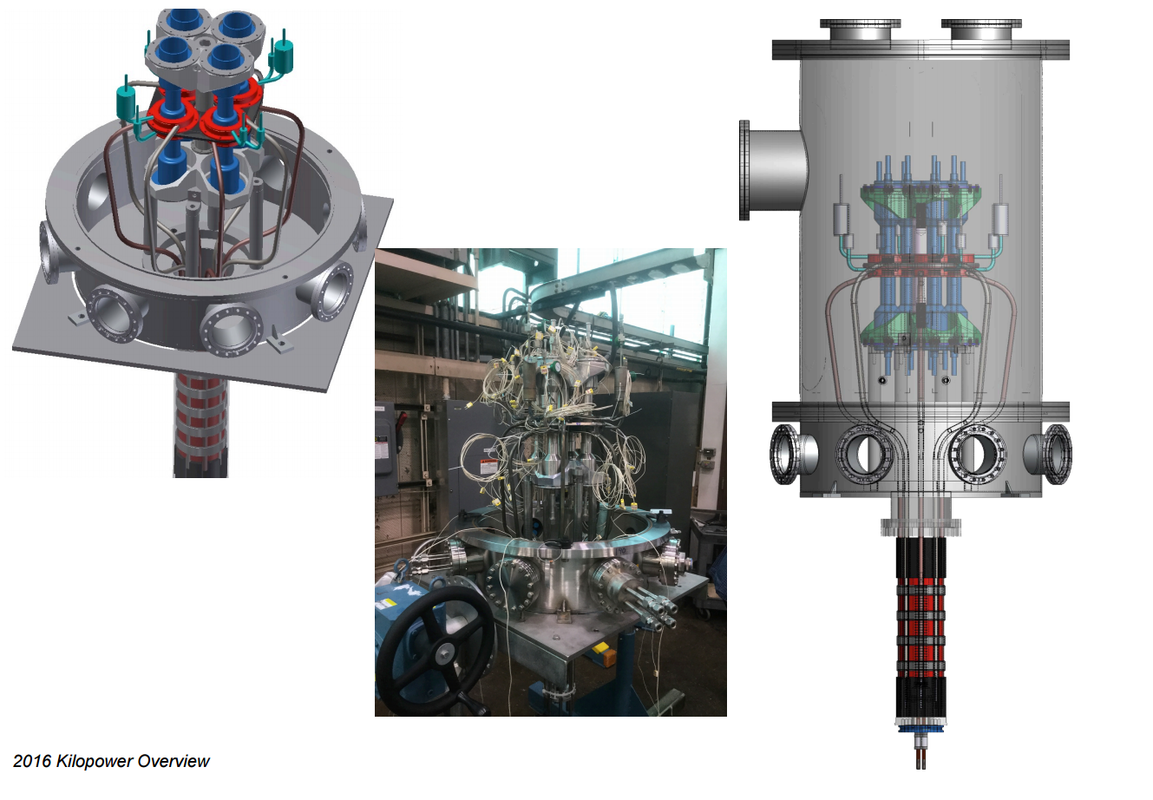
Passed in 2016, tests at the NASA Glenn Center assembled from a reactor simulator (made from an alloy of lunch uranium heated by heating elements) and 8 Stirling generators assembled in pairs in 4 assemblies. Stand for testing the system in vacuum.
The competitiveness of RTGs with Pu238 Kilopower is distinguished by much greater cheapness (35 kg of highly enriched uranium costs about $ 0.5 million, compared to about $ 50 million for 45 kg of Pu238 required for a kilowatt RTG) and much less handling problems during the preparation of the spacecraft and its launch, but today developers from LANL have been talking about the ten-year life of the reactor, while the RTGs of the Voyagers have been working for 40 years - somewhere this may be an important circumstance.
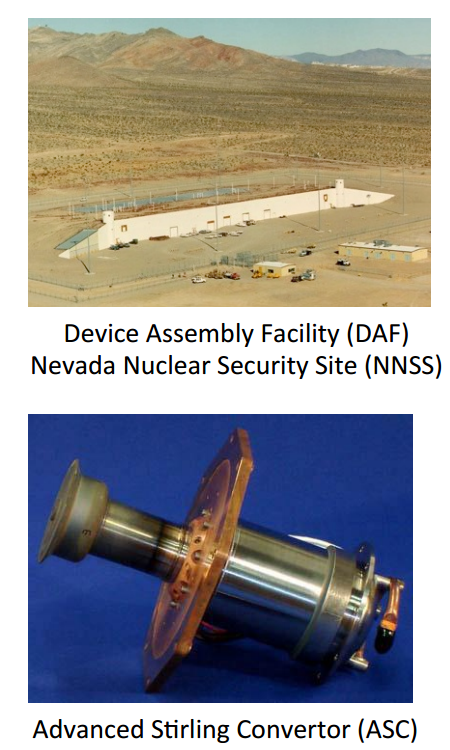
The test site in Nevada, where the reactor tests and the Stirling generator will remain, which NASA has left after the Stirling RTG creation program.
The ten-year period of work, apparently, is mainly limited to the mechanical part of the reactor (Stirling generators). In any case, the uranium core for 10 years of operation at a power of 4 kilowatts (thermal) will burn out less than 0.1%, and the swelling and damage to the material will be about 1/10 of the thermal expansion, the reduction in power due to poisoning is also considered insignificant.
Video from LANL, telling about the project (in English).
An important circumstance for space is the mass of the reactor. NASA collects its RTGs from cubes, with a minimum option in the form of a MMRTG weighing 45 kg and a power of 125 watts, there is also a GPHS-RTG weighing about 60 kg and a power of 300 electrical watts, while the minimum version of Kilopower is 1 kW weighs about 300 kg, of which the reactor and radiation protection weigh about 230 kg. Unfortunately, not every NASA device sent to deep space has a mass reserve of 100-250 kg, even at the expense of saving $ 50 million for plutonium 238.
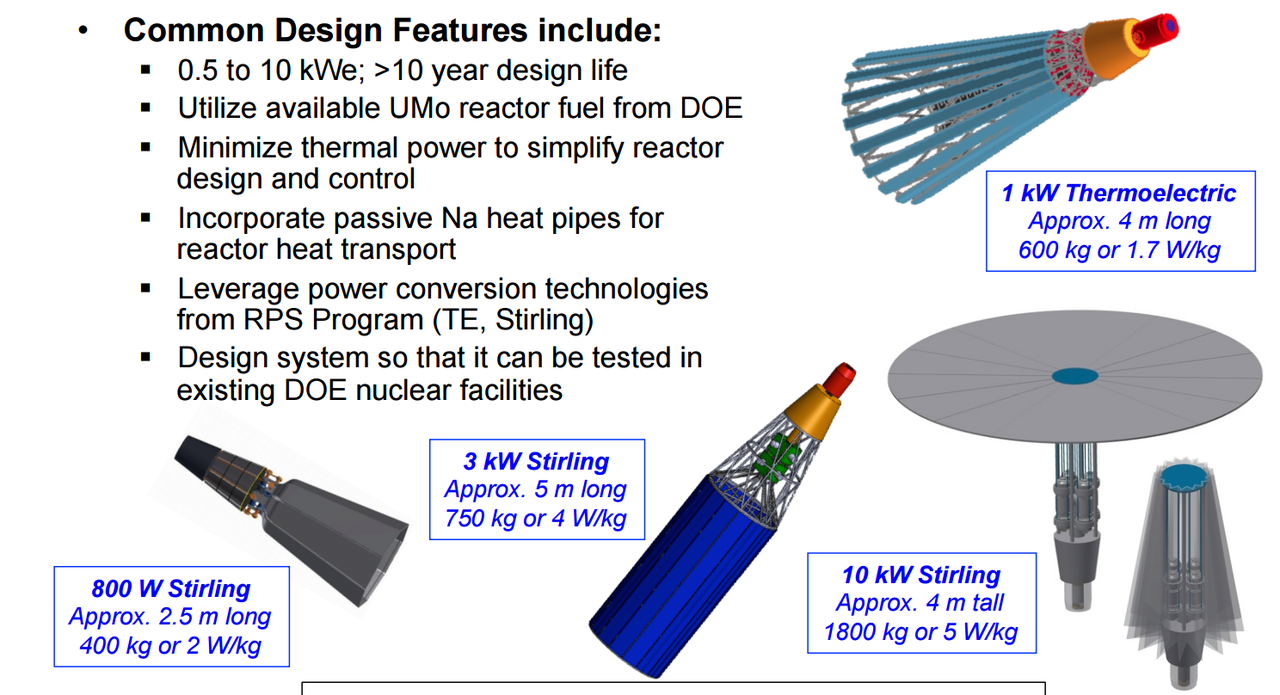
Different options for energy sources that can be created on the basis of Kilopower.
In principle, the Kilopower developers would definitely be on horseback if DOE hadn't beenresumed the production program of Pu238 - after all, in 2011, when the project of this space reactor actually started, the possibility of restoring production of Pu238 was still hypothetical, which fueled interest in alternatives.

A little more iron - tests of heat pipes and a “reactor-pipe” heat model in a vacuum test bench.
During the development, LANL specialists proposed and calculated the construction of a kilowatt uranium reactor, and more - conducted a small experiment on its Flattop critter assembly, surrounded by a beryllium reflector. The experiment was to install a micro styrling and a heat pipe into the critical assembly, which made it possible to get 25 watts of electrical power from the heat of the chain reaction for some time, so to speak, of proof.
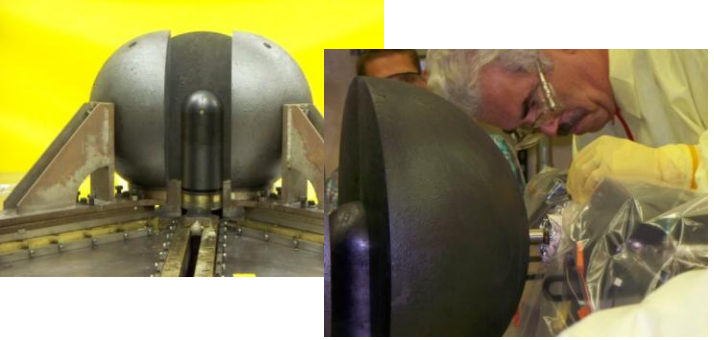
The flattop assembly and sliding beryllium reflector, in the right sidebar - the installation of a heat pipe and a stirling generator to it.
After a successful demonstration, the Kilopower project received direct funding from NASA and NNSA (this is the agency involved in the storage, production and trafficking of nuclear materials in the US) for 16.17 and 18 years, which involves creating a prototype kilowatt generator with a real nuclear reactor (!) And testing it in 2018 Nevada. The Y-12 plant (usually engaged in the production of nuclear weapons) will be engaged in reactor production, the reflector will fabricate LANL, the thermal part of the reactor, the vacuum stand and the biosecurity for testing will be done by the Marshal Center of NASA, the module with reactor simulator (electrically heated uranium core) will be tested in 2017 in the center of Glenn NASA.

Plans for the Kilopower project. ISRU - getting rocket fuel on-site (on Mars), GRC - Glenn NASA center, SBIR - a program of developing a wide range of NASA technologies
Against the background of “large” reactors projects that go through all circles of development, stand construction, stand tests, regulatory approvals security booths, etc. For decades, a project of such duration, simplicity and with a good probability of flying into space cannot but rejoice. He will begin to delight even more if he is selected as an energy source in one of the distant missions that are going to space in the next decade.
PS Interesting NASA presentation on aspects of using nuclear energy in a mission visiting Mars
P.PSSlightly unintelligible (explanations start from the middle), but a rather unique video on the development of the late 80s and early 90s - the SP-100 high-temperature space reactor, which was planned mainly for military use, which is still partially classified.
The project is interesting because many conventions in appearance have been rejected here that prevail in different paper reactors, and the low level of complexity allows us to make the design as simple as that of RTGs, which in fact can lead this project to success. The simple design and the correct ideology make it possible to go through the development stages at a very high speed, which is not typical of decades of space nuclear reactor projects.

The conceptual image of Kilopower, from left to right, is radiators / refrigerators, 2 assemblies of Stirling generators, radiation protection and heat pipes, a reflector of a beryllium oxide reactor (a reactor inside it).
Kilopower power should be from 1 to 10 kW of electric (and 4 times higher - thermal, which gives a efficiency of 25%), and be configured for a specific mission. What is interesting, as I understand it, only the heat-electric part will change from power, and the nuclear part, in fact, will remain approximately the same for all options. The reactor, which is being worked out in the American laboratory of LANL, is a cylinder made of 7% molybdenum alloy and highly enriched uranium 235, which (HEU) is for some reason afraid of space reactor developers, although no terrorists or dictators behind Jupiter’s orbit have yet been found. The cylinder diameter is ~ 11 cm, length 25 cm, weight ~ 35 kg, inside there is a channel 3.7 cm in diameter, where the only boron carbide rod is located.

Molybdenum in the alloy with uranium is needed here to impart mechanical strength and stability of uranium to phase transitions during heating, and reactivity is regulated by boron carbide neutron absorber from boron carbide - in the inserted state the reactor is subcritical even when released into water, in the seized (once and for all) - goes to the criticism and gaining thermal power. Power is governed by the geometry of the reactor and the reflector, which is chosen so that when heated to 1200 K, the thermal expansion of the uranium alloy of the reactor reduces Keff (the neutron ratio in the next generation) strictly to 1, and then it will warm up for more than 10 years with the ongoing chain reaction.

Plate with calculated Keff reactor: 1) a cold reactor with a withdrawn rod, 2) a cold reactor with a rod inserted, 3) a heated reactor with a withdrawn rod at the start of operation 4) a heated reactor with a withdrawn rod after 10 years of burnout.
The reactor is surrounded by a neutron reflector (to reduce the critical mass) of beryllium oxide, into which heat pipes are inserted - and this is absolutely the whole construction of the reactor itself. Between the block of energy converters and the active zone there is a segment (shadow, protecting only in one direction) radiation protection from layers of lithium hydride and tungsten.
The most amazing thing in my opinion is the absence of a shell in the uranium core - it is not needed in space, on earth this reactor never starts up. It remains only to envy the unbeaten thinking and the lack of atomic surveys in the orbit of Neptune.

The reactor core and two options for fixing heat pipes on it. By the way, fixing heat pipes to uranium is one of the unexpectedly difficult problems in this development, mainly because the remaining elements of the reactor are simple or have been worked out.
Heat removed from the core and the reflector by heat pipes is supplied to the hot ends of the Stirling generators (in different studies of the reactor their number and power are different, but probably about 4-16 pieces), and their cold ends are connected to radiator coolers. Here, too, there is a robust simplicity in the design - heat pipes are widely used in spacecraft, and Stirling generators for space NASA has been testing for the second decade. At the same time, it is believed that the Stirling closed gas structure is better than the branched and requiring a lot of equipment design of turboelectric transducers (on the Brighton cycle, fashionably referred to in Western articles as the Brayton units).

Passed in 2016, tests at the NASA Glenn Center assembled from a reactor simulator (made from an alloy of lunch uranium heated by heating elements) and 8 Stirling generators assembled in pairs in 4 assemblies. Stand for testing the system in vacuum.
The competitiveness of RTGs with Pu238 Kilopower is distinguished by much greater cheapness (35 kg of highly enriched uranium costs about $ 0.5 million, compared to about $ 50 million for 45 kg of Pu238 required for a kilowatt RTG) and much less handling problems during the preparation of the spacecraft and its launch, but today developers from LANL have been talking about the ten-year life of the reactor, while the RTGs of the Voyagers have been working for 40 years - somewhere this may be an important circumstance.

The test site in Nevada, where the reactor tests and the Stirling generator will remain, which NASA has left after the Stirling RTG creation program.
The ten-year period of work, apparently, is mainly limited to the mechanical part of the reactor (Stirling generators). In any case, the uranium core for 10 years of operation at a power of 4 kilowatts (thermal) will burn out less than 0.1%, and the swelling and damage to the material will be about 1/10 of the thermal expansion, the reduction in power due to poisoning is also considered insignificant.
Video from LANL, telling about the project (in English).
An important circumstance for space is the mass of the reactor. NASA collects its RTGs from cubes, with a minimum option in the form of a MMRTG weighing 45 kg and a power of 125 watts, there is also a GPHS-RTG weighing about 60 kg and a power of 300 electrical watts, while the minimum version of Kilopower is 1 kW weighs about 300 kg, of which the reactor and radiation protection weigh about 230 kg. Unfortunately, not every NASA device sent to deep space has a mass reserve of 100-250 kg, even at the expense of saving $ 50 million for plutonium 238.

Different options for energy sources that can be created on the basis of Kilopower.
In principle, the Kilopower developers would definitely be on horseback if DOE hadn't beenresumed the production program of Pu238 - after all, in 2011, when the project of this space reactor actually started, the possibility of restoring production of Pu238 was still hypothetical, which fueled interest in alternatives.

A little more iron - tests of heat pipes and a “reactor-pipe” heat model in a vacuum test bench.
During the development, LANL specialists proposed and calculated the construction of a kilowatt uranium reactor, and more - conducted a small experiment on its Flattop critter assembly, surrounded by a beryllium reflector. The experiment was to install a micro styrling and a heat pipe into the critical assembly, which made it possible to get 25 watts of electrical power from the heat of the chain reaction for some time, so to speak, of proof.

The flattop assembly and sliding beryllium reflector, in the right sidebar - the installation of a heat pipe and a stirling generator to it.
After a successful demonstration, the Kilopower project received direct funding from NASA and NNSA (this is the agency involved in the storage, production and trafficking of nuclear materials in the US) for 16.17 and 18 years, which involves creating a prototype kilowatt generator with a real nuclear reactor (!) And testing it in 2018 Nevada. The Y-12 plant (usually engaged in the production of nuclear weapons) will be engaged in reactor production, the reflector will fabricate LANL, the thermal part of the reactor, the vacuum stand and the biosecurity for testing will be done by the Marshal Center of NASA, the module with reactor simulator (electrically heated uranium core) will be tested in 2017 in the center of Glenn NASA.

Plans for the Kilopower project. ISRU - getting rocket fuel on-site (on Mars), GRC - Glenn NASA center, SBIR - a program of developing a wide range of NASA technologies
Against the background of “large” reactors projects that go through all circles of development, stand construction, stand tests, regulatory approvals security booths, etc. For decades, a project of such duration, simplicity and with a good probability of flying into space cannot but rejoice. He will begin to delight even more if he is selected as an energy source in one of the distant missions that are going to space in the next decade.
PS Interesting NASA presentation on aspects of using nuclear energy in a mission visiting Mars
P.PSSlightly unintelligible (explanations start from the middle), but a rather unique video on the development of the late 80s and early 90s - the SP-100 high-temperature space reactor, which was planned mainly for military use, which is still partially classified.
